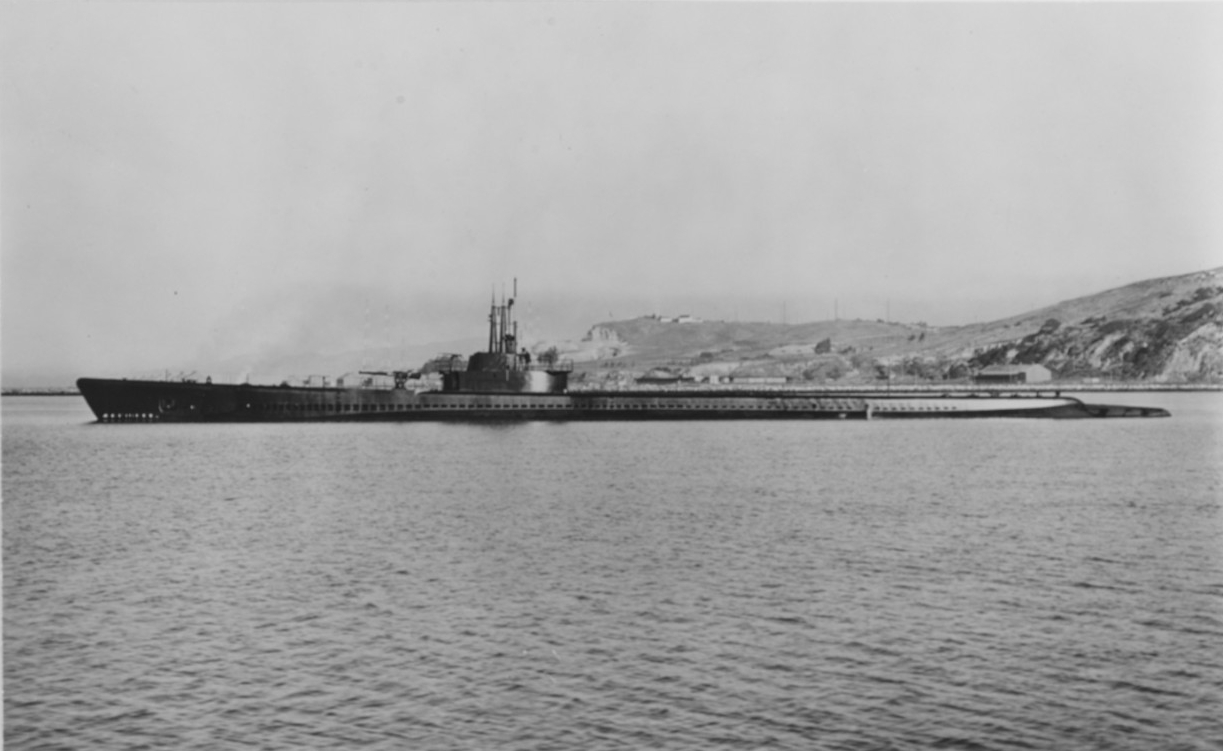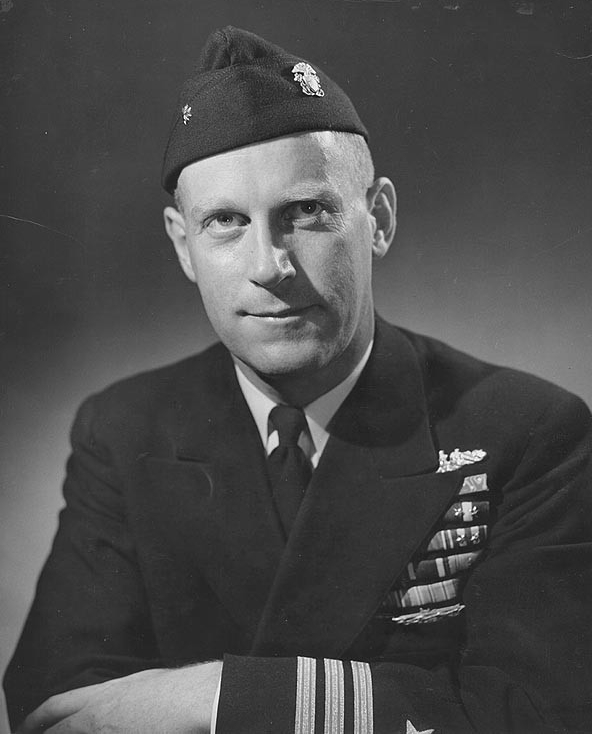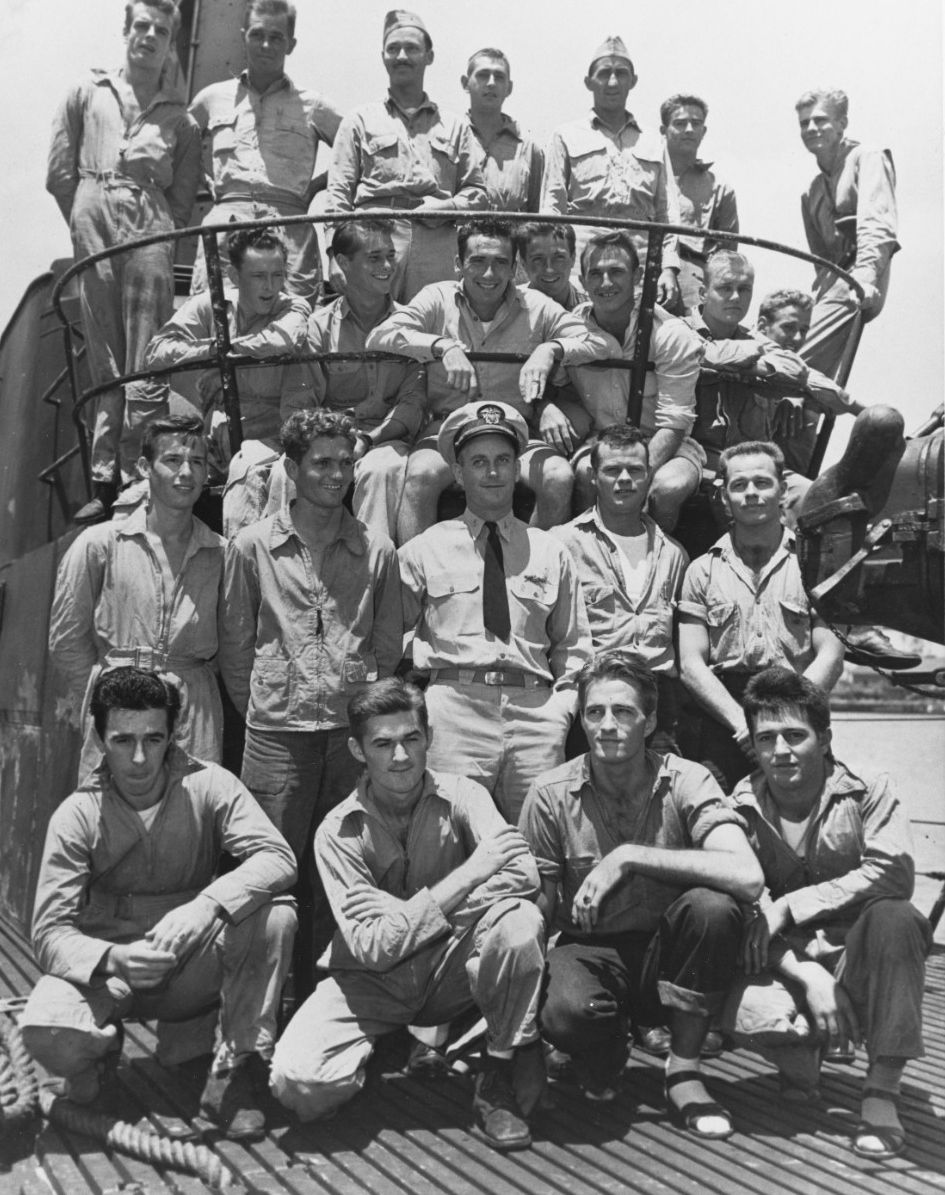Tang I (SS-306)
1943-1945
Any surgeonfish, especially of the several West Indian species.
I
(SS-306: displacement 1,525 (surfaced), 2,424 (submerged); length 311'6"; beam 27'2"; draft 15'2"; speed 20.25 knots (surfaced), 8.75 knots (submerged); complement 66; armament 10 21-inch torpedo tubes, 1 4-inch, 2 20 millimeter; class Balao)
The first Tang (SS-306) was laid down on 15 January 1943 at Vallejo, Calif., by the Mare Island Navy Yard; launched on 17 August 1943; sponsored by Mrs. Antonio S. Pitre; and commissioned on 15 October 1943, Lt. Cmdr. Richard H. O'Kane in command.
Tang completed fitting out at Mare Island and then moved south to San Diego for 18 days of intensive training before sailing for Hawaii. She arrived at Pearl Harbor on 8 January 1944 and conducted two more weeks of exercises in preparation for combat. Tang stood out of Pearl Harbor on 22 January to begin her first war patrol in the Caroline-Mariana Islands area.
On the morning of 17 February 1944, she sighted a convoy of two freighters, their escorts, and five smaller ships. The submarine tracked the convoy, plotted its course, and then prepared to attack. An escort suddenly appeared at a range of 7,000 yards and closing. Tang went deep and received five depth charges before the escort departed. Undamaged, she returned to periscope depth and resumed the attack. The range on the nearest freighter closed to 1,500 yards, and Tang fired a spread of four torpedoes. Three of them hit, and Gyoten Mam sank by the stern. The submarine cleared the area by running deep and then attempted to get ahead of the convoy for a dawn attack, but the remaining freighter passed out of range under air escort.
During the night of 22 February 1944, Tang made a surface attack on a convoy of three cargo ships and four escorts. She tracked the Japanese ships for half an hour before attaining a firing position 1,500 yards off the port bow of a freighter. A spread of four torpedoes hit Fukuyama Maru from bow to stern, and the enemy ship disintegrated. Early the next morning, Tang made another approach on the convoy. The escort of the lead ship Yamashimo Maru moved from its covering position on the port bow, and the submarine slipped into it and fired four torpedoes. The first hit the stern of the cargoman; the second struck just aft of the stack; and the third burst just forward of the bridge and produced a terrific secondary explosion. The ship was twisted, lifted from the water, and began belching flames as she slid beneath the waves.
On the morning of the 24th, Tang sighted a tanker, a freighter, and a destroyer. Rain squalls hampered her as she attempted to attain a good firing position, so she tracked the ships until night and then made a surface attack. She fired four torpedoes and scored three hits which sank the freighter. The two remaining ships commenced firing in all directions, and Tang submerged to begin evasive action. She shadowed the enemy until morning and then closed the tanker for a submerged attack. Additional lookouts had been posted on the target's deck and, when the spread of torpedoes from Tang struck her, they were hurled into the air with other debris from the ship. Echizen Maru sank in four minutes as Tang went deep and rigged for the depth charge attack that followed. The next day, the submarine sank Choko Maru, a 1,794-ton cargo ship.
Tang contacted a convoy consisting of a freighter, transport, and four escorts on the evening of the 26th. She maneuvered into position to attack the wildly zigzagging transport and fired her last four torpedoes. All passed astern as the transport speeded up. Having expended all of her torpedoes and scored 16 hits out of 24 attempts, the submarine put into Midway Island for refit.
Tang's second patrol began on 16 March 1944 and took her to waters around the Palaus, to Davao Gulf, and to the approaches to Truk. She made only five surface contacts and had no opportunity to launch an attack before she was assigned to lifeguard duty near Truk. Tang rescued 22 downed airmen and transported them to Hawaii at the conclusion of the patrol.
Tang's (SS-306) commanding Officer, Lieutenant Commander Richard H. O'Kane (center), poses with the 22 aircrewmen that the submarine rescued off Truk during the carrier air raids there on 29 April-1 May 1944. The photograph was taken upon Tang's return to Pearl Harbor from her second war patrol, in May 1944. Official U.S. Navy photograph now in the collections of the National Archives, 80-G-227987.
Her third war patrol was one of the most devastating carried out against Japanese shipping during the war. Tang got underway from Pearl Harbor on 8 June 1944 and hunted enemy shipping in the East China Sea and Yellow Sea areas. On the 24th, southwest of Kagoshima, the submarine contacted a convoy of six large ships guarded by 16 escorts. Tang closed for a surface attack and fired a spread of three torpedoes at one of the ships and quickly launched a similar spread at a second target. Explosions followed, and Tang reported two ships sunk. However, postwar examination of Japanese records revealed by the Japanese government show that two passenger/cargo ships and two freighters were sunk. The ships must have overlapped, and the torpedo spread must have hit and sunk two victims in addition to their intended targets. Those sunk; Tamahoko Maru, Tainan Maru, Nasusan Maru, and the Kennichi Maru added up to 16,292 tons of enemy shipping.
On 30 June 1944, while she patrolled the lane from Kyushu to Dairen, Tang sighted another cargo ship steaming without an escort. After making an end-around run on the surface which produced two torpedo misses, Tang went deep to avoid depth charges; then surfaced and chased the hapless ship until she closed the range to 750 yards. A single torpedo blew Nikkin Maru in half, and the merchantman sank.
The next morning, Tang sighted a tanker and a freighter. While she sank freighter Taiun Maru No. 2, tanker Takatori Maru No. 1 fled. The submarine trailed until dark; then fired two torpedoes which sent the latter down. Tang celebrated the Fourth of July 1944 at dawn by an end-around, submerged attack on an enemy freighter which was near shore. However, with rapidly shoaling water and her keel about to touch bottom, Tang backed off; fired a spread of three with two hits; and then surfaced as survivors of the 6,886-ton cargo ship Asukazan Maru were being rescued by fishing boats. That afternoon, Tang sighted Yamaoka Maru, another cargo ship of approximately the same size, and sank her with two torpedoes. The submarine surfaced and, with the aid of grapnel hooks and Thompson submachine guns, rescued a survivor who had been clinging to an overturned lifeboat. While prowling the waters off Dairen late the next night, the submarine sighted a cargo ship and, during a submerged attack with her last two torpedoes, sank Dori Maru. The box score for her third patrol was 10 enemy merchant ships sunk that totaled 39,160 tons.
Her fourth war patrol was conducted from 31 July to 3 September 1944 in Japanese home waters off the coast of Honshu. On 10 August, she,fired a spread of three torpedoes at a tanker near the beach of Omai Saki with no hits. The next day, after locating two freighters and two escorts, she launched three torpedoes at the larger freighter and two at the other. The larger freighter disintegrated, apparently from a torpedo which exploded in her boilers. As the submarine went deep, her crew heard the fourth and fifth torpedoes hit the second ship. After a jarring depth charge attack which lasted 38 minutes, Tang returned to periscope depth. Only the two escorts were in sight, and one of them was picking up survivors.
On the 14th, Tang attacked a patrol yacht with her deck gun and reduced the Japanese ship's deck house to a shambles with eight hits. Eight days later, she sank a 225-foot patrol boat. On 23 August, the submarine closed a large ship; Japanese in white uniforms could be seen lining its superstructure and the bridge. She fired three torpedoes, and two hits caused the 8,135-ton transport Tsukushi Maru to slip under the waves. Two days later, Tang sank a tanker and an escort with her last three torpedoes and then returned to Pearl Harbor.
After a refit and overhaul, Tang stood out to sea on 24 September 1944 for her fifth war patrol. After topping off with fuel at Midway, she sailed for Formosa Strait on the 27th. On the night of 10 and 11 October, she sank the cargo ships Joshu Go and Oita Maru. The submarine continued on patrol until the 23rd when she contacted a large convoy consisting of three tankers, a transport, a freighter, and numerous escorts. Comdr. O'Kane planned a night surface attack. Tang broke into the middle of the formation, firing torpedoes as she closed the tankers (later identified as freighters). Two torpedoes struck under the stack and engine room of the nearest; a single burst into the stern of the middle one; and two exploded under the stack and engine space of the farthest. The first torpedoes began exploding before the last was fired, and all hit their targets which were soon either blazing or sinking. As the submarine prepared to fire at the tanker which was crossing her stern, she sighted the transport bearing down on her in an attempt to ram.
Tang had no room to dive so she crossed the transport's bow and with full left rudder saved her stern and got inside the transport's turning circle. The transport was forced to continue her swing to avoid the tanker which had also been coming in to ram. The tanker struck the transport's starboard quarter shortly after the submarine fired four stern torpedoes along their double length at a range of 400 yards. The tanker sank bow first and the transport had a 30° up angle. With escorts approaching on the port bow and beam and a destroyer closing on the port quarter, Tang rang up full speed and headed for open water. When the submarine was 6,000 yards from the transport, another explosion was observed aboard that ill-fated ship, and its bow disappeared.
On the morning of 24 October 1944, Tang began patrolling at periscope depth. She surfaced at dark and headed for Turnabout Island. On approaching the island, the submarine's surface search radar showed so many blips that it was almost useless. Tang soon identified a large convoy which contained tankers with planes on their decks and transports with crated planes stacked on their bows and sterns. As the submarine tracked the Japanese ships along the coast, the enemy escorts became suspicious; and the escort commander began signaling with a large searchlight. This illuminated the convoy, and Tang chose a large three-deck transport as her first target, a smaller transport as the second, and a large tanker as the third. Their ranges varied from 900 to 1,400 yards. After firing two torpedoes at each target, the submarine paralleled the convoy to choose its next victims. She launched stern torpedoes at another transport and tanker aft. As Tang poured on full speed to escape the gunfire directed at her, a destroyer passed around the stern of the transport and headed for the submarine. The tanker blew up, and a hit was seen on the transport. A few seconds later, the destroyer blew up, either from intercepting Tang's third torpedo or from shell fire of two escorts closing on the beam. Only the transport remained afloat, and it was dead in the water.
The submarine cleared to 10,000 yards, rechecked the last two torpedoes which had been loaded in the bow tubes; and returned to finish off the transport. The 23rd torpedo was fired at 900 yards and was observed running hot and straight. The last torpedo was fired. It broached and curved to the left in a circular run. Tang fishtailed under emergency power to clear the turning circle of the torpedo, but it struck her abreast the after torpedo room approximately 20 seconds after it was fired. Tang sank by the stern. Those who escaped the submarine were greeted in the morning with the bow of the transport sticking straight out of the water. Nine survivors, including the commanding officer, were picked up the next morning by a Japanese destroyer escort. They spent the remainder of the war in prison camps.
In the last attack, Tang had sunk Kogen Maru and Matsumoto Maru. During her brief career, Tang accounted for 30 Japanese ships for a total of 100, 491 tons. Tang was stricken from the Navy Register on 8 February 1945.
Tang received two Presidential Unit Citations and four battle stars for her World War II service. Her commanding officer received the Medal of Honor for Tang's final action.
Corrected, Robert J. Cressman
16 August 2023





